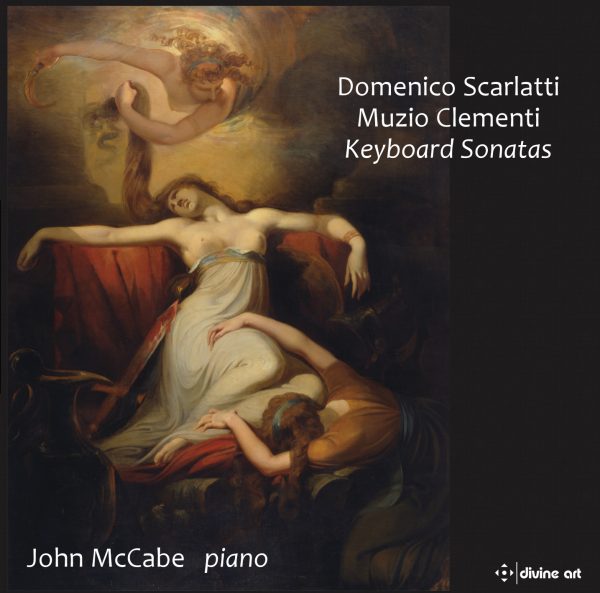Infodad
Note from Divine Art: review written by an apparent ‘historic authenticity’ fundamentalist: points raised are indisputable but maybe we can now be a bit more accepting, as baroque and early classical works have been played on modern instruments for quite a while
The appeal of a new Divine Art release featuring pianist/composer John McCabe (1939-2015), is likely to be wide-ranging, even though McCabe’s renditions of works by Domenico Scarlatti and Muzio Clementi are neither historically correct nor performed on the instruments intended by the composers. Both Scarlatti (1685-1757) and Clementi (1752-1832) wrote for the harpsichord or, in some works by Clementi, the fortepiano, and playing this music on a full-size modern Bösendorfer piano, as McCabe does, is simply not correct. It is, however, mostly wonderful: McCabe does not overdo his pedal use, performs each work with care and clarity, and – with a few notable exceptions – does not make the pieces sound as if they belong in the Romantic era. This is not a new recording: it was made in 1981 and originally released on two Hyperion discs, and it was recorded, mixed and edited on analog equipment before being digitally mastered for CD release. But McCabe’s pianism on these works certainly stands the test of time – and, for that matter, so does the sound, which has greater warmth and richness than did most digital recordings from this time period. Whether warmth and richness are apt for this music is, however, a reasonable question to ask. Scarlatti’s 555 harpsichord sonatas are notable for their clarity of line, their exploratory techniques (many from his middle period feature difficult hand-crossings), and their complexity within their brief one-movement form. Their numbering is mostly arbitrary and does not reflect their dates of composition, so performers tend to come up with their own ways to arrange them, as McCabe does here. He offers three major/minor pairs, in G major/minor (K105/426), D minor/major (K517/490), and F minor/major (K69/518); then a pair in E major (K28/215); and finally a set of four in C, G, G minor and C (K133, 259, 43, 460). Only two of these do not quite work: K517 simply sounds too strongly Romantic with the emphasis McCabe gives to its bass line, and K133 is emphatically chordal on the piano in a way that it would not be on the harpsichord. In the remaining works, though, McCabe’s sensitivity to the music’s structure and his willingness to downplay the piano sound rather than emphasize it lead to a highly enjoyable listening experience, even though it is historically inappropriate. McCabe actually makes a better case for playing Clementi on a modern concert grand, thanks to an excellent selection of music. The Sonata in G minor, Op. 50, No. 3 (Didone Abbandonata – scena tragica) is the highlight of this two-CD release. It is Clementi’s last piano sonata and the only one to which he gave a programmatic title. And it is quite marvelous, evoking the despair of Dido upon the departure of her faithless lover, Aeneas, in three movements whose tempo indications sum up the work’s emotional superstructure exceptionally well: Largo patetico e sostenuto – Allegro ma con espressione; Adagio dolente; and Allegro agitato e con disperazione. This really is a proto-Romantic (if not quite fully Romantic) sonata, and McCabe handles its moods and moodiness with exceptional sensitivity. It is a piece that definitely deserves to be heard more often, providing it can be played with this level of power and beauty (which, however, is by no means assured). The other two Clementi sonatas, although not at this level, are fine works in their own right: the two-movement Sonata in F, Op. 33, No. 2, in which the forceful main section of the first movement is especially impressive; and the three-movement Sonata in D, Op. 40, No. 3, which has a tragedy-pervaded mood despite its major key, the central slow movement being particularly heartfelt. Between those two sonatas, McCabe plays three of the 12 little salon pieces called Monferrinas, Op. 49 – Nos. 4 in C, 3 in E and 12 in C. These are versions of Italian folk dances (from Montferrat; hence the title), and McCabe handles them with considerable spirit and a welcome lightness of touch that contrasts well with his approach to the tragic moods of the Op. 40 and Op. 50 sonatas. McCabe’s skillful presentation of this material occurs, in the main, in spite of his use of the modern concert grand, not because of it: he holds back on the full force of the piano so as to communicate the textures of Clementi’s music more effectively than would be possible otherwise. But this simply draws attention to the reality that Clementi (and Scarlatti) did not write for this sort of instrument at all. True, they might well have been impressed if it had existed in their time. But if it had, they would not have written this music for it – they would have written music to take advantage of what a modern concert grand can do. That said, McCabe provides a generally excellent listening experience in these works, despite presenting them on an instrument quite different from what the composers wanted.
@divineartrecordingsgroup
A First Inversion Company
Registered Office:
176-178 Pontefract Road, Cudworth, Barnsley S72 8BE
+44 1226 596703
Fort Worth, TX 76110
+1.682.233.4978












